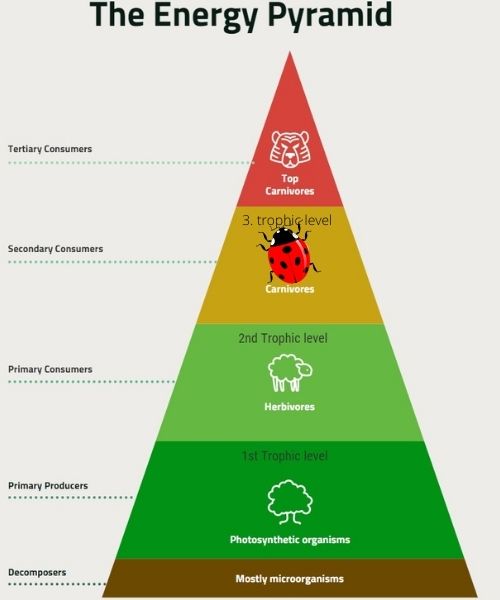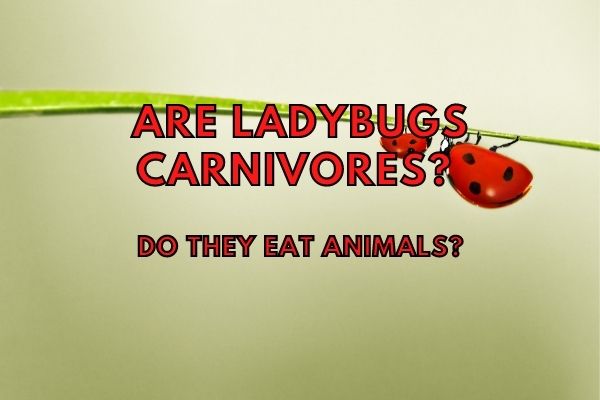Some species, yes! Many ladybugs are carnivores that play an important role in the food web as secondary consumers, but it depends on the species of ladybug!
Ladybugs are carnivores that mainly eat aphids, scales, mealy bugs, leafhoppers, mites and other small insects. However, a few species are omnivores as they will also eat nectar and pollen on occasion.
Ladybugs are important for agriculture since they help control pests. Aphids, for example, are a major pest of many crops since they feed on plant sap.
By eating aphids, ladybugs help to keep populations in check and prevent crop damage.
Are Ladybugs Carnivores, Herbivores or Omnivores?
Ladybugs, scientifically known as ladybirds or lady beetles, are fascinating creatures with a diverse diet that varies across different species.
To answer your question, ladybugs can be considered both carnivores and omnivores, depending on the species and their life stages. Their dietary habits are influenced by factors such as availability of prey and environmental conditions.
The majority of ladybug species are carnivorous during their larval stage. Ladybug larvae have an insatiable appetite for small, soft-bodied insects, particularly aphids.
Aphids are notorious pests that damage plants by feeding on their sap, and ladybug larvae are highly effective natural predators in controlling aphid populations.
These larvae have strong mandibles, which they use to grasp and consume their prey. Some examples of ladybug species that exhibit carnivorous behavior include the convergent ladybug (Hippodamia convergens), the seven-spotted ladybug (Coccinella septempunctata), and the Asian lady beetle (Harmonia axyridis).
However, ladybugs undergo a remarkable transformation during their pupal stage, emerging as adults with hardened wing covers.
As adults, ladybugs continue to feed on small insects but also incorporate plant material into their diet, making them omnivorous.
They often consume pollen, nectar, and honeydew, a sugary substance excreted by aphids and other sap-sucking insects. This additional food source provides essential nutrients and energy for their reproductive activities.
It’s important to note that while most ladybug species are primarily carnivorous or omnivorous, there are a few exceptions.
For instance, the Mexican bean beetle (Epilachna varivestis) is an herbivorous ladybug species that primarily feeds on the leaves and pods of various leguminous plants. This behavior sets it apart from the typical diet of other ladybugs.
Ladybugs play a crucial role in maintaining the balance of ecosystems and controlling pest populations.
Their carnivorous nature helps protect plants from destructive insects, while their omnivorous tendencies allow them to gather resources from the plant kingdom as well. These tiny, polka-dotted insects exemplify the intricate relationships between different organisms in nature and the adaptability of species to different dietary requirements.
So, to summarize, ladybugs can be classified as both carnivores and omnivores, depending on the species and life stage. Their diet includes small, soft-bodied insects like aphids during their larval stage, and as adults, they incorporate plant material such as pollen and nectar into their diet. While most ladybug species exhibit carnivorous or omnivorous behavior, there are exceptions, like the herbivorous Mexican bean beetle.
Herbivore Ladybug Species
The vast majority of ladybugs are predators, however, and only a handful of species are known to be herbivores.
The Mexican bean beetle (no longer called a ladybug, but belongs to the same family) is a noticeable example of a herbivorous ladybug. It feeds mostly on the leafs of plants in south and central America where it is considered a pest.

Other herbivorous ladybugs include the squash beetle, which feeds on cucurbit plants like squash and pumpkins, and the rosemary beetle, which consumes rosemary leaves.
The 24-spot ladybird is an other interesting example of a ladybug that does not eat other insects or plants! It is a fungivore that eats the molds growing on celery, carrot and parsley plants.
Are Ladybugs Producers, Consumers or Decomposers?
Ladybugs, scientifically known as ladybird beetles or lady beetles, are fascinating creatures that play important roles in ecosystems worldwide. When it comes to their ecological role, ladybugs are primarily consumers.
They are considered beneficial insects as they feed on a variety of garden pests, such as aphids, mites, scale insects, and other soft-bodied insects. By consuming these pests, ladybugs help control their populations and contribute to the overall health of plants and crops.
As consumers, ladybugs belong to the group of organisms known as predators. They have a voracious appetite for small insects and larvae, making them valuable natural pest control agents. Ladybugs are equipped with specialized mouthparts for chewing and a strong digestive system that allows them to consume large numbers of prey in a short time.
While most ladybugs primarily consume insects, there are a few species that have herbivorous tendencies during certain stages of their life cycle.
For instance, the Mexican bean beetle (Epilachna varivestis) and the squash beetle (Epilachna borealis) are ladybug species that feed on plant foliage, particularly beans and squash plants, respectively. These herbivorous ladybugs may be considered both consumers and herbivores, depending on the stage of their life cycle and their feeding habits.
Ladybugs are not considered producers or decomposers. Producers are organisms, such as plants and algae, that can convert sunlight into energy through the process of photosynthesis. Decomposers, on the other hand, are organisms like bacteria and fungi that break down organic matter and aid in the recycling of nutrients. Ladybugs do not engage in either of these processes.
In summary, ladybugs are primarily consumers, specifically predators that feed on a wide range of garden pests. While most ladybug species are insectivores, a few species may exhibit herbivorous tendencies during certain stages of their life cycle. However, they are not classified as producers or decomposers. Understanding the ecological roles of ladybugs helps us appreciate their beneficial contributions to the balance of ecosystems and the well-being of plants and crops.
What Type of Consumer is a Ladybug?
Ladybugs are secondary consumers because they obtain their energy by eating primary consumers.
Secondary consumers are organisms that can only obtain their food by consuming other organisms. Most animals are primary consumers, but secondary consumers are animals that only eat secondary consumers.
Can Ladybugs be Considered Decomposers?
Ladybugs do not eat dead or decaying matter and are therefore not decomposers. However, the microbes in the gut of the ladybug may be considered true decomposers.
Ladybugs are not typically considered decomposers. Decomposers are organisms that play a vital role in breaking down dead organic matter, such as dead plants, animals, and other organic materials, into simpler compounds and returning nutrients to the soil. Examples of decomposers include bacteria, fungi, and certain types of insects.
Ladybugs, however, do not have a significant role in the decomposition process. Their primary diet consists of small insects and pests, such as aphids, mites, and scale insects. Ladybugs are predators, consuming live prey rather than dead organic matter. They do not actively participate in breaking down dead organisms or recycling nutrients like decomposers do.
While ladybugs may occasionally encounter dead insects or decaying organic material, their focus is primarily on consuming live prey. If they come across dead insects, they are more likely to scavenge on the live larvae or eggs of those insects rather than actively decomposing the dead bodies.
Therefore, it is more accurate to consider ladybugs as consumers and predators, playing a beneficial role in controlling pest populations, rather than as decomposers involved in the breakdown of dead organic matter.
Therefore, no ladybug species are decomposers because decomposers are bacteria and fungi.
Where are Ladybugs in the Food Chain?
Ladybugs, as consumers and predators, occupy an important position in the food chain or food web of ecosystems. They can be found at various trophic levels, depending on the specific species and their feeding habits.

Ladybugs are generally considered secondary consumers in the food chain. They feed on primary consumers, which are typically herbivorous insects or pests that consume plants. Ladybugs are voracious predators, especially when it comes to soft-bodied insects like aphids, mites, and scale insects. By feeding on these primary consumers, ladybugs help regulate their populations and maintain the balance of the ecosystem.
In some cases, ladybugs may even be considered tertiary consumers. This means they feed on other secondary consumers, such as insects or small organisms that themselves prey on herbivorous insects. Ladybugs that occupy this trophic level often consume other insect species, expanding their diet beyond herbivorous pests.
It’s worth noting that ladybugs themselves can also become prey for other organisms. They may be consumed by birds, spiders, certain wasps, and other insectivorous predators. This places ladybugs as an important link between the primary producers (plants) and higher-level consumers in the food chain.
Ultimately, ladybugs contribute to the transfer of energy and nutrients through their feeding habits, playing a vital role in maintaining the ecological balance of their respective habitats.
Are Ladybugs Autotrophs or Heterotrophs?
Ladybugs are true heterotrophs because they eat other living organisms. Practically no animals are autotrophic because animals do not get their energy directly from the sun like plants do. That is, animals like the ladybug do not make their own energy, but need to eat other organisms as their energy and carbon source.
What Animals Hunt and Eat Ladybugs?
Ladybugs have predators like birds, lizards, and spiders. Birds and spiders eat ladybugs as their prey. Ladybugs also have predators like ants, spiders, and mites.
Ladybugs, despite their bright colors that often serve as a warning to potential predators, are preyed upon by various animals in their natural habitats. Some of the common predators of ladybugs include:
- Birds: Many bird species, such as swallows, sparrows, wrens, and starlings, include ladybugs in their diet. Birds are attracted to the conspicuous colors of ladybugs, which signal their toxicity or unpleasant taste. However, not all ladybug species are distasteful to birds, and some birds may avoid consuming them due to their bright colors.
- Spiders: Spiders are skilled hunters that can capture ladybugs in their webs or through direct hunting. They often use their silk threads to immobilize ladybugs and then inject them with venom before consuming them.
- Wasps: Certain species of wasps, such as the wasp family Vespidae, including yellow jackets and paper wasps, prey on ladybugs. They may capture and paralyze ladybugs to feed them to their larvae as a source of food.
- Mantises: Praying mantises are known to feed on a wide range of insects, including ladybugs. They have powerful forelegs that they use to capture and hold their prey while devouring them.
- Insectivorous mammals: Some small mammals, such as shrews and bats, may include ladybugs in their diet, especially if they come across them while foraging for other insects.
It’s important to note that the specific predators of ladybugs can vary depending on the region and habitat. Additionally, the toxicity or unpleasant taste of certain ladybug species can act as a deterrent to potential predators.
Ladybugs, particularly those with bright and contrasting colors, have evolved to signal their unpalatability to predators, reducing the likelihood of being consumed.
Conclusion
In this post I have taken you through some of the most important parts of the ladybug diet. We have looked at the habitat of ladybugs, their primary diet and the position of ladybugs in the food chain!
Ladybugs are a very common and widespread group of insects. They are found in many different habitats around the world.
Ladybugs are carnivorous and have a number of different predators including birds, spiders, wasps and bats.
Ladybugs are a very important group of insects for a number of reasons. They are important pollinators, they are very beneficial for the ecosystem and they are also very beneficial for humans! Ladybugs are also very good at controlling pests, including aphids, and they are often used to control aphids in crops.
Ladybugs are also very good at eating aphids, which means they can be an important part of a sustainable agriculture system.
Ladybugs are also very beneficial for humans because they can eat harmful species of aphids, and they are a good source of protein and calcium!





